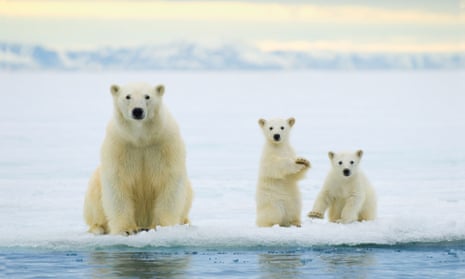The news that polar bears were consuming more land-based foods, such as bird eggs, geese and caribou – the results of a study from the American Museum of Natural History in New York last year – was exactly the sort of optimism people had been looking for in the polar bear’s sad story. Despite the fact that various scientists came out saying it was unclear whether this new foraging strategy would help polar bears survive, what the media heard was essentially: “Polar bears are adapting, hooray!”
Headlines perpetuated this perception. “Stuck on land? Polar bears find ways to grab dinner,” proclaimed Daily Climate News. “As Sea Ice Shrinks, Can Polar Bears Survive on Land?” National Geographic asked optimistically. And study author, ecologist Linda J Gormezano, calculated that polar bears may be able to survive for six months on land-based foods.
Karyn Rode, lead author of a study out today from the US Geological Services (USGS), provides a bit of a reality check.
“I can see why people would get excited about the news that polar bears are eating land-based foods,” Rode said. “Why wouldn’t we hope for polar bears to find a way to cope with sea ice loss?”
The USGS study, however, points out that while some polar bears may eat terrestrial foods, there is no evidence that the behavior is widespread. In addition to the fact that only a small percentage of polar bears — fewer than 30 individual polar bears out of populations that typically number 900 to 1200 — are actually consuming land-based foods, Rode and her colleagues found that in the regions where terrestrial feeding by polar bears has been documented, polar bears’ health and rate of survival have declined.
The study also points out that polar bears will be competing for any land-based foods with existing populations of grizzly bears. And those grizzlies are among the smallest and most malnourished of the species because there’s so little to eat.
“The smaller size and low population density of grizzly bears in the Arctic,” Rode said, “provides a clear indication of the nutritional limitations of onshore habitats for supporting large-bodied polar bears in meaningful numbers.”
Polar bears are the largest bear species, largely due to the fact that they consume the highest fat diet of any mammal (consisting primarily of seals and other marine mammals). Replacing lost ice-based hunting opportunities with foods available on land means switching from high-fat foods to primarily carbohydrate and protein-based foods.
Moreover, the study points out that foraging has a cost associated with it. Polar bears foraging on low quality, dispersed resources, such as berries, will burn more calories.
“The exception to low-quality foods onshore, are bird eggs,” Rode said. “But there are limited numbers of bird eggs when considered as a food source for an entire population of 900 or more bears.”
According to Rode, a lot more research needs to be done before we get a clear understanding of how, or whether, polar bears will adapt to a changing arctic landscape. Other less intrusive studies could also help us understand if polar bears are increasingly using terrestrial foods, according to Rode.
“Previous studies found that polar bears in western Hudson Bay spent 80-85% of their time resting while onshore,” Rode said. “That is not suggestive that terrestrial foods could be a substantial part of their diet.”

Comments (…)
Sign in or create your Guardian account to join the discussion